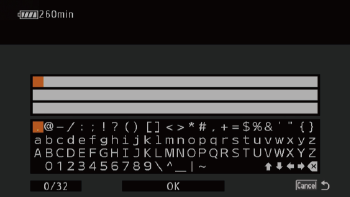Transferring Clips from the Camcorder via a Wired Network (FTP File Transfer) (XF200 / XF205)
| Article ID: ART115954 | | | Date published: 05/12/2015 | | | Date last updated: 02/20/2024 |
Description
Transferring Clips from the Camcorder via a Wired Network (FTP File Transfer) (XF200 / XF205)
Solution
| Transferring Clips from the Camcorder via a Wired Network (FTP File Transfer) (XF200 / XF205)
ID : 8202113200 _ EN _ 2
|
|
| Solution |
After connecting the camcorder to a network, you can transfer clips from the camcorder to another device connected to the network using the FTP protocol. In [CAMERA] mode, you can transfer the last MP4 clip just recorded. In [MEDIA] mode, you can transfer multiple clips or photos stored in the recording media in the camcorder.
The following explanations assume that the FTP server is on, ready and correctly configured.
The procedure for making the necessary settings to use the FTP File Transfer feature are explained in the following steps. Please proceed in order from step one.
 Step 1: Making FTP Transfer Preparations Step 1: Making FTP Transfer Preparations Step 2: Making Wired Network Connections Step 2: Making Wired Network Connections Step 3-A: Transferring a Newly Recorded MP4 Clip Step 3-A: Transferring a Newly Recorded MP4 Clip Step 3-B: Transferring a Clip or Photo Step 3-B: Transferring a Clip or Photo
Step 1: Making FTP Transfer Preparations
1. Hold down the button on the <POWER> switch and slide the switch to <CAMERA>.

2. Press the <MENU> button.
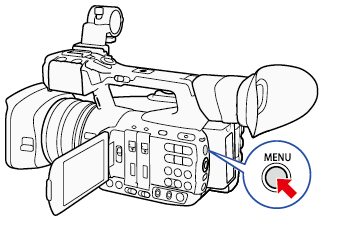
3. Push the joystick up/down to select [
 Other Functions] > [Network Settings] > [FTP Server Settings] and then press <SET>. Other Functions] > [Network Settings] > [FTP Server Settings] and then press <SET>.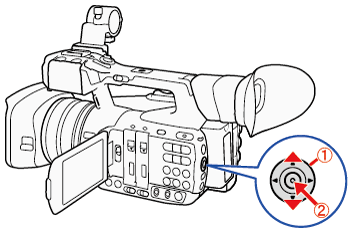  : Joystick : Joystick : In the following procedures, 'Press <SET>' refers to the action of pressing the joystick straight down to select the desired setting. : In the following procedures, 'Press <SET>' refers to the action of pressing the joystick straight down to select the desired setting.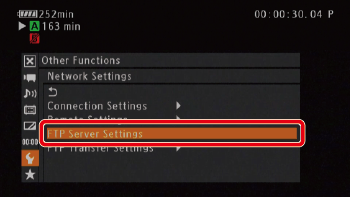
4. Enter the [FTP Server].
Select [Input] and then press <SET>.
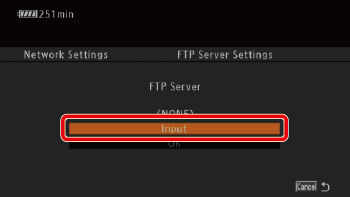
Enter the FTP servers IP address or host name (such as 192.168.XX.XX ) using the keyboard screen.
After you have finished entering the information, select [OK] and press <SET>.
5. Enter the [User Name] in the same way.
Select [Input] and then press <SET>.
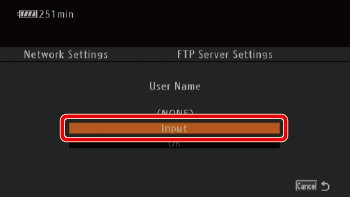 Enter the [User Name].
After you have entered the information, select [OK] and then press <SET>.
6. Enter the [Password].
Select [Input] and then press <SET>.
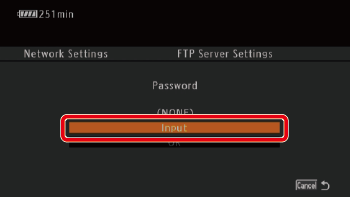 Enter the [Password].
After you have entered the information, select [OK] and then press <SET>.
7. Enter the [Destination Folder] if necessary.
Select [Input] and then press <SET>.
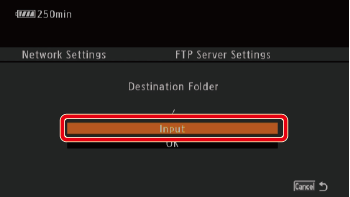 Enter the [Destination Folder]. ('/' has been entered in the example image above.)
After you have entered the information, select [OK] and then press <SET>.
8. Enter the [Port No.] if necessary.
Select [Input] and then press <SET>.
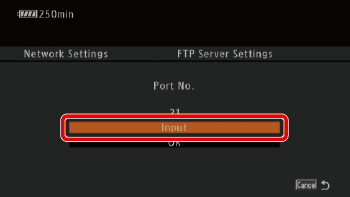
9. Push the joystick up/down to select a value for the first digit and then press <SET> to move to the next digit.
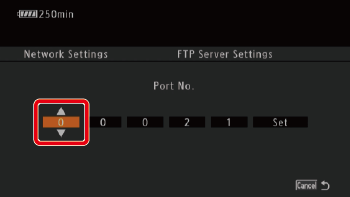 Make sure to enter all the digits ('21' has been entered in the example image above).
10. Select [Set] appearing on the right side of the screen, and then press <SET>.
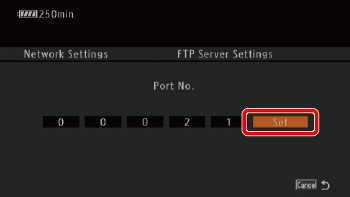
11. Select [OK] and then press <SET>.
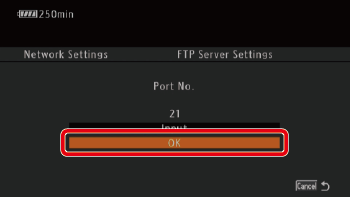
12. Select whether to turn the passive mode [On] or [Off] and then press <SET>.
([Off] has been selected in the example image below.)
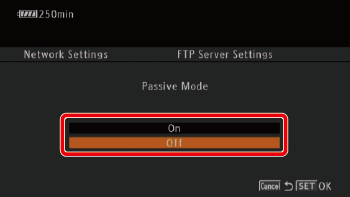
13. Select [OK] and then press <SET>.
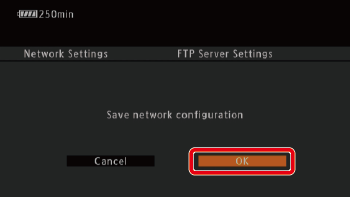
14. Press <SET>.
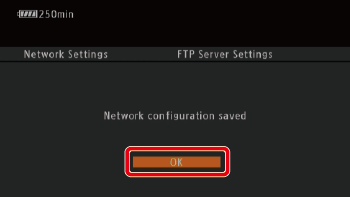
15. Perform the FTP Transfer settings.
These settings determine the handling of files and folders on the FTP server.
15. Select [
 Other Functions] -> [Network Settings] -> [FTP Transfer Settings], and then press <SET>. Other Functions] -> [Network Settings] -> [FTP Transfer Settings], and then press <SET>.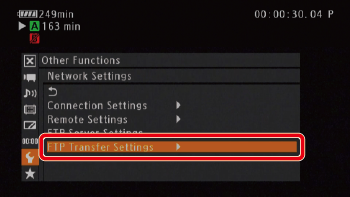
16. Select [Create Folder by Date] and press <SET>.
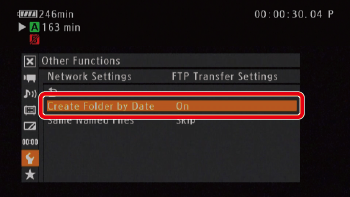
17. Select the desired option and then press <SET>.
[On]: A new subfolder under the transfer destination folder "YYYYMMDD\HHMMSS" will be created for every transfer operation.
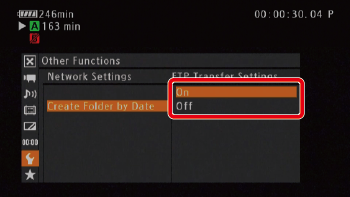
18. Select [
 Other Functions] -> [Network Settings] -> [FTP Transfer Settings] -> [Same Named Files] and then press <SET>. Other Functions] -> [Network Settings] -> [FTP Transfer Settings] -> [Same Named Files] and then press <SET>.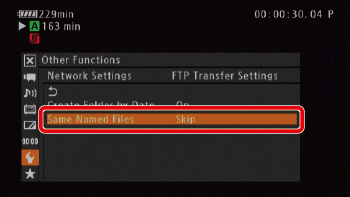
19. Select the desired option and then press <SET>.
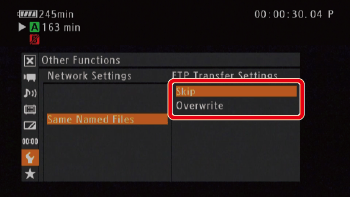
20. Press the <CANCEL> button to return to the previous menu. ([Network Settings] submenu of [
 Other Functions]). Other Functions]).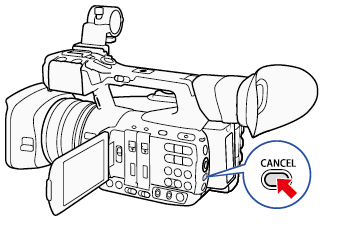 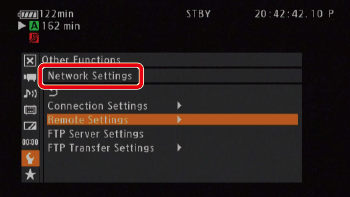
Step 2: Making Wired Network Connections
1. Connect a commercially available LAN cable to the LAN terminal on the camcorder and a LAN port on a network device.
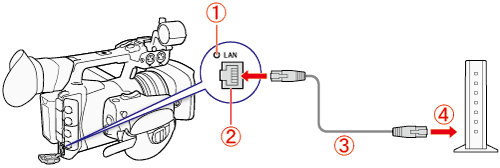  : LAN access indicator : LAN access indicator : LAN terminal : LAN terminal : LAN cable (commercially available) : LAN cable (commercially available) : LAN port on a network device : LAN port on a network device
2. Select [
 Other Functions] -> [Network Settings] -> [Connection Settings] -> [Set Up New] and then press <SET>. Other Functions] -> [Network Settings] -> [Connection Settings] -> [Set Up New] and then press <SET>.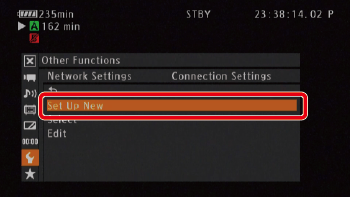
3. Select [Ethernet] and then press <SET>.
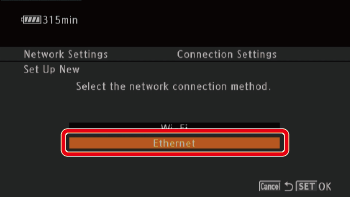
4. Select the method for assigning the IP address and then press <SET>.
The steps for performing [Manual] settings are explained below.
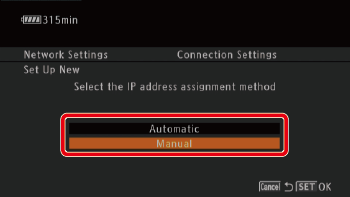
5. Enter the IP address, Subnet Mask, and Default Gateway.
Push the joystick up/down to select a value for the first field and then press <SET>.
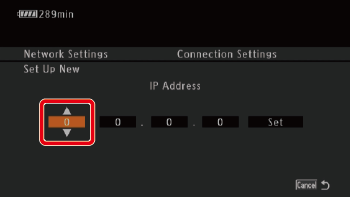
The cursor will move to the next field.
Repeat the process for all four fields.
6. Select [Set] on the right side of the screen and then press <SET> to confirm the address.
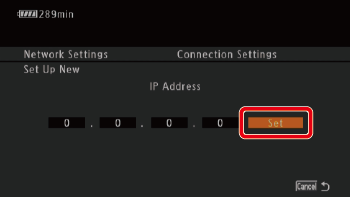
7. Enter the [Subnet Mask] and [Default Gateway] addresses in the same way.
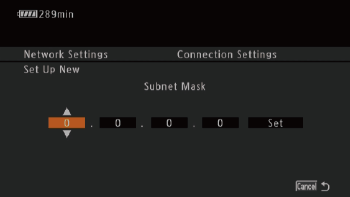
8. Select the desired method for setting up the DNS server, and then press <SET>.
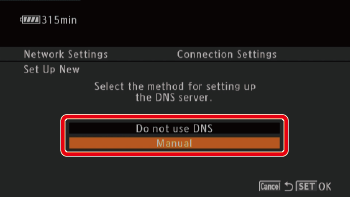
The [Manual] setting procedure is explained below.

9. Enter the [Primary DNS Server] and [Secondary DNS Server] using the process explained above for entering the IP address.
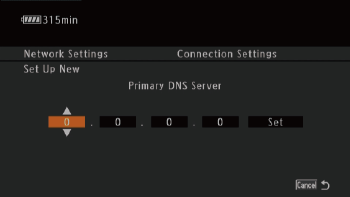
10. Confirm the settings.
Push the joystick up/down to review additional settings before pressing <SET>.
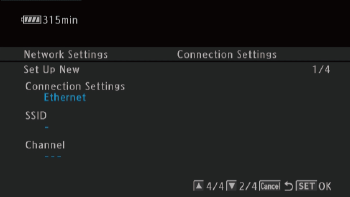
11. Save the settings.
Push the joystick up/down to select the desired configuration number and then press <SET>.
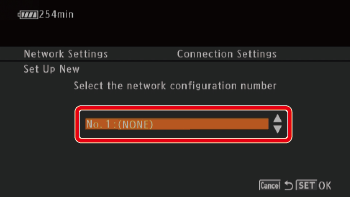
12. If necessary, enter the [Network Configuration Name].
Select [Input] and then press <SET>.
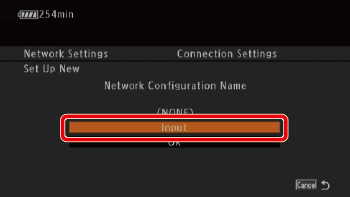
Enter the network configuration name.
Select [OK] and then press <SET>.
13. Select [OK] and then press <SET>.
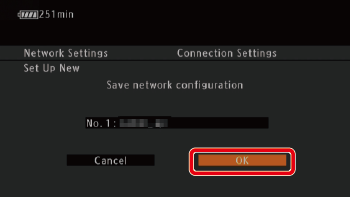
You can save up to 5 different network configuration profiles in the camcorder. If you select a configuration number that was already in use, the previous configuration will be overwritten by the new one.
14. Press <SET>.
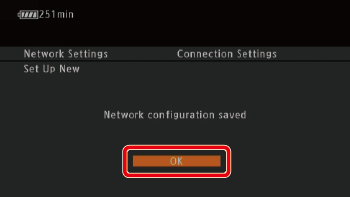
15. Press the <CANCEL> button twice to return to the menu before the previous menu ([
 Other Functions]). Other Functions]).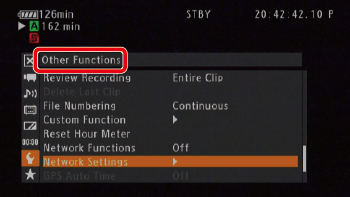
To transfer a newly recorded MP4 clip, please proceed to Step 3-A.
Step 3-A: Transferring a Newly Recorded MP4 Clip.
If you activate the FTP transfer function and set in advance an assignable button to [MP4 FTP Transfer], you can press the button to add the last MP4 clip recorded to the FTP transfer queue (up to 5 clips). MP4 clips are then transferred to the FTP server one by one. The FTP transfer is performed in the background so you can continue recording while the files are transferred. In fact, the transfer will not be interrupted even if you set the camcorder to [MEDIA] mode.
The following section explains the procedure for assigning [MP4 FTP Transfer] to assignable button 5 and adding clips to the FTP transfer queue.
1. Select [
 Other Functions] -> [Assignable Buttons] and choose the desired button (5 has been selected in the example image below). Then, press <SET>. Other Functions] -> [Assignable Buttons] and choose the desired button (5 has been selected in the example image below). Then, press <SET>.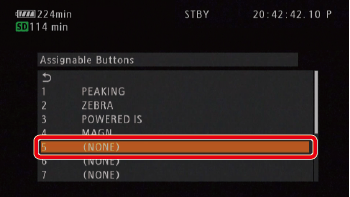
2. Select [MP4 FTP Transfer] and press <SET>.
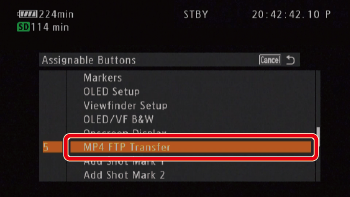
3.Press the <CANCEL> button to return to the previous menu. ([
 Other Functions]). Other Functions]).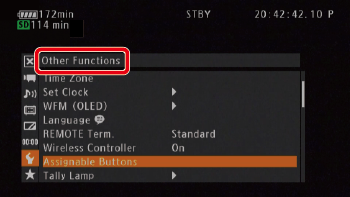
4. Select [
 Other Functions] -> [Network Settings] -> [Connection Settings] -> [Select] and then press <SET>. Other Functions] -> [Network Settings] -> [Connection Settings] -> [Select] and then press <SET>.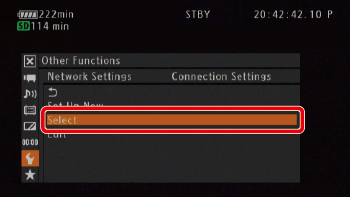
5. Select the configuration number you saved in step 2, and then press <SET>.
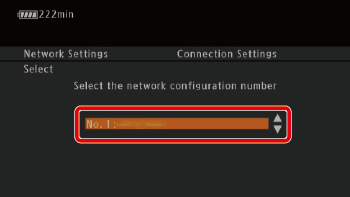
Immediately after making new network settings, the setting number for the new network will be selected automatically, so this step will not be necessary.
6. Press [CANCEL] twice to return to the menu before the previous menu ([
 Other Functions]). Other Functions]).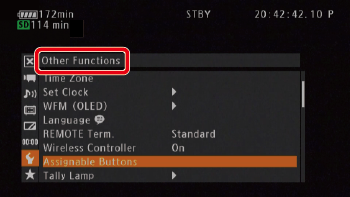
7. Activate the FTP transfer function.
Select [
 Other Functions] -> [Network Functions] -> [FTP Transfer] and then press <SET>. Other Functions] -> [Network Functions] -> [FTP Transfer] and then press <SET>.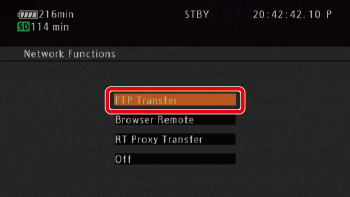
The [
 ] icon will appear on the screen, and the camcorder will be set to FTP transfer mode. ] icon will appear on the screen, and the camcorder will be set to FTP transfer mode.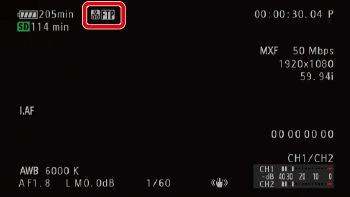
8. After recording an MP4 clip, press assignable button 5 (which you set to [MP4 FTP Transfer] in the previous steps).
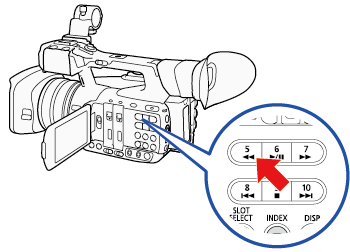
The MP4 clip just recorded will be added to the FTP transfer queue.
The number of MP4 clips in the FTP transfer queue will appear next to the [
 ] icon. ] icon.
9. When you have finished transferring the desired clips, turn off the network functions.
Set [
 Other Functions] -> [Network Functions] to [Off] and then press <SET>. Other Functions] -> [Network Functions] to [Off] and then press <SET>.The network icons will turn yellow and then disappear from the screen.
Step 3-B: Transferring Clips and Photos
You can transfer to the FTP server MXF clips recorded on the CF card and MP4 clips or photos recorded on the SD card. The procedure for sending clips is explained below, but photos can be sent in the same way.
1. Hold down the button on the <POWER> switch and slide the switch to <MEDIA>.

2. Press the <MENU> button.

3. Select [
 Other Functions] -> [Network Settings] -> [Connection Settings] -> [Select] and then press <SET>. Other Functions] -> [Network Settings] -> [Connection Settings] -> [Select] and then press <SET>.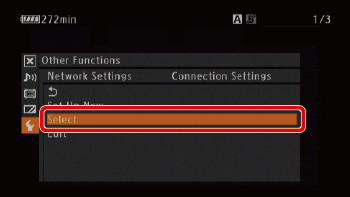
4. Select the configuration number you saved in step 14 of the previous section (Step 2), and then press <SET>.

Immediately after making new network settings, the setting number for the new network will be selected automatically, so this step will not be necessary.
5. Press the <MENU> button.
To transfer one clip or photo, please proceed to 6-a.To transfer multiple clips or photos, please proceed to 6-b.
6-a. Transferring one clip or photo.
6-a-1. Press the <INDEX> button to open the index screen that contains the clips or photos you want to transfer.
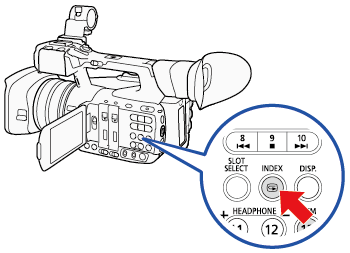
6-a-2. Select the desired clip or photo and then press <SET> to open the clip/photo menu.
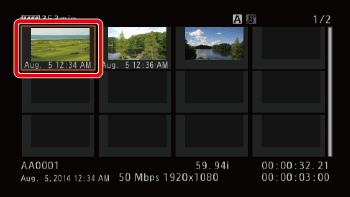
6-a-3. Select [FTP Transfer] and then press <SET>.
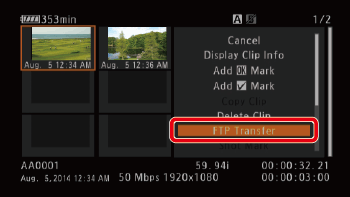
6-a-4. Select [OK] and then press <SET>.
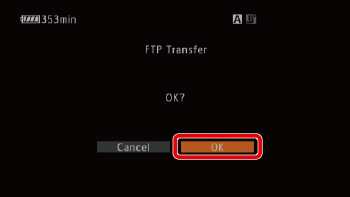
FTP will appear on the top of the screen, next to the connection type icon.
When the icons turn white, the clip/photo will be transferred to the FTP server.
Select [Cancel] instead to cancel the operation.
When the transfer is completed, the network icons will turn yellow and then disappear from the screen.
6-a-5. When the confirmation message appears, press <SET>.
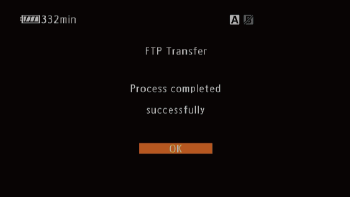
This concludes the procedure for transferring one clip or photo.
6-b. Transferring Multiple Clips or Photos.
6-b-1. Press the <INDEX> button to open the index screen that contains the clips or photos you want to transfer.

6-b-2. Select [
 Other Functions] > [Clips] or [Photos] > [FTP Transfer] and then press <SET>. Other Functions] > [Clips] or [Photos] > [FTP Transfer] and then press <SET>.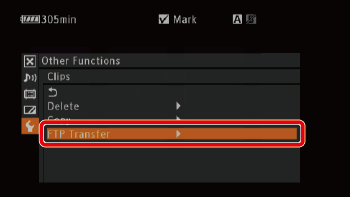
6-b-3. Select [Select] to select which clips/photos to transfer, or [All] to transfer all the clips/photos and then press <SET>.
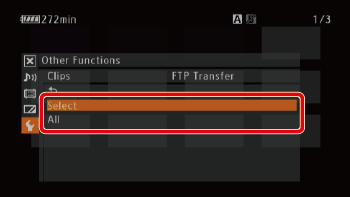
6-b-4. If you selected [Select].
Select the desired clip and press <SET>.
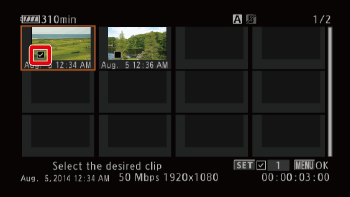
6-b-5. Repeat the process to select all the clips you would like to transfer.
6-b-6. Press the <MENU> button.
6-b-7. Select [OK] and then press <SET>.
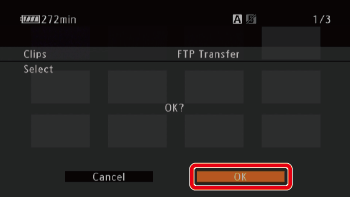
FTP will appear on the top of the screen, next to the connection type icon.
6-b-8. When the icons turn white, all the applicable clips/photos will be transferred to the FTP server. When using a LAN connection, the LAN access indicator will flash quickly while the files are being transferred.

Select [Cancel] instead to cancel the operation.
6-b-9. When the transfer is completed, the network icons will turn yellow and then disappear from the screen.
6-b-10. When the confirmation message appears, press <SET>.

This concludes the procedure for transferring multiple clips or photos.
|
SIMS Doc Id
8202113200


 ] / [
] / [  ] / [
] / [  ] / [
] / [  ]) to change the position of the cursor and the backspace character [
]) to change the position of the cursor and the backspace character [  ] to delete the last character entered.
] to delete the last character entered.